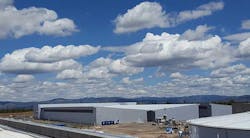Today we continue our Data Center Executive Roundtable, a quarterly feature showcasing the insights of thought leaders on the state of the data center industry, and where it is headed. In today’s discussion, our panel of experienced data center executives – Jakob Carnemark of Aligned Energy, Robert McClary of FORTRUST, Rick Crutchley of IO, Dan Papes of Digital Realty and Brian Kortendick of BASELAYER – will examine the enterprise cloud and its evolution, and what this means for the distribution of IT workloads across in-house and third-party data centers.
The conversation is moderated by Rich Miller, the founder and editor of Data Center Frontier.
Data Center Frontier: There are signs that cloud technologies are gaining traction in the enterprise sector. How is this affecting the balance of the deployment of enterprise workloads between on-premises facilities, service provider data centers, and public cloud platforms? What will this look like in 2017?
BRIAN KORTENDICK of BASELAYER
Brian Kortendick: Enterprises across the globe have been tasked with exploring whether moving to a public cloud can deliver richer customer experiences, streamline operations, and/or reduce budgetary spending. While this has resulted in large cloud adoption, we still see readiness of the underlying applications as the most influential factor .
For example, a company that requires low latency transactions might benefit from strategically located IT assets rather than a public cloud option. Still another company with sensitive data may elect to keep IT assets local while pushing back-office capabilities to a public cloud. While, a third company may require a re-coding of their applications to work in a cloud environment and therefore may opt to deploy only new applications in a private cloud.
The diversity of applications within an enterprise should result in an IT strategy equally as diverse; the right mix of public cloud, private cloud, colocation and on-premise assets. The common thread for 2017 that we do see across these examples is if providers can standardize around a common data center form factor, providers will offer end users the ability to seamlessly move assets and capabilities their various options.
DAN PAPES of Digital Realty
Dan Papes: Today, 39 percent of enterprise workloads run in the cloud, and that number is projected to climb to 57 percent in just two years’ time. Driven by both technological and economic factors, we’ve seen a large increase in adoption of multi-cloud strategies, allowing enterprises to spread workloads and risk across multiple cloud environments and geographical locations.
Hybrid cloud will continue to be the norm, with enterprises retaining some of their critical infrastructure and data on-premises. Some, who had previously migrated a majority of their workloads to the cloud, will even begin reversing the trend due to reduced economies of scale, given the exponential growth in the numbers and volume of their applications and workloads. It’s a delicate balance that depends on a variety of factors that continue to shift over time.[clickToTweet tweet=”Dan Papes: Today, 39 percent of enterprise workloads run in the cloud. That will climb to 57 percent in 2 years.” quote=”Dan Papes: Today, 39 percent of enterprise workloads run in the cloud. That will climb to 57 percent in 2 years.”]
A recent survey from leading IT professionals indicates that 82 percent of enterprises are adopting a multi-cloud strategy, citing security, managing multiple clouds and a lack of resources as the top three challenges in leveraging the cloud effectively. Digital Realty is committed to helping enterprises tackle these concerns and efficiently manage high-performance interconnections between internal applications and cloud resources in a secure and cost-effective environment.
Through our Service Exchange offering, we’re enabling enterprises to develop and deploy a multi-cloud strategy more easily, naturally and cost effectively than ever before. Multi-Cloud Management through a single interface on Service Exchange helps to reduce the complexity of managing multiple critical applications for varied lines of business.
RICK CRUTCHLEY of IO.
Rick Crutchley: The number of platforms that enterprise IT is supporting will increasingly include public cloud. This will become challenging to manage and more and more complex. On-premise infrastructure will continue to grow and stretch the capability of the IT department to manage it.
My opinion is that the IT department will still want to manage as much as they can on-premise, so a hybrid approach between on premise, service providers/colocation, and public cloud platforms will be very common in 2017.
Providers are making it easier to move and balance workloads across public and private infrastructure. Hardware vendors are leveraging public cloud technologies in their products to enable clients to utilize the benefits of the public cloud while not giving up the control and security they get by having the infrastructure on site.
Robert McClary, FORTRUST
Robert McClary: I think with the fact that a lot of enterprises are looking to incorporate cloud technology in their IT environments, with respect to whether it’s infrastructure-as-a-service or platform-as-a-service, this is going to accelerate the growth of service provider data centers because a lot of those choices in cloud offerings are going to need a marketplace type environment.
And what better than a multi-tenant data center or colocation provider to be able to establish that for the end user? The enterprise IT consumer really wants choice and convenience. They don’t want to be tied to one individual cloud offering, whether public, private or hybrid. They want to be able to choose among several types of cloud offerings and providers. The colocation data center then sets up well to be able to provide that to the enterprise user.[clickToTweet tweet=”Rob McClary: Security usually defines whether you choose private or public cloud. Those lines are becoming blurrier. ” quote=”Rob McClary: Security usually defines whether you choose private or public. Those lines are becoming blurrier. “]
You can have a business unit in one cloud and another business unit in a separate cloud. Or different areas of transactional functions. Hybrid cloud was a mix of private and public cloud. Everything’s hybrid now. There’s some things you want to put in public clouds and some things you don’t. Security usually defines whether you choose private or public. Those lines are becoming a lot blurrier. A lot of it is just people becoming better educated on what cloud platforms actually have in place when it comes to security and what they don’t. When you’re looking at your IT workloads, you’re going to have to make decisions on which ones you want in private cloud, which ones are okay to be in public cloud, and which ones you’re going to want to have on your own hardware to be able to control.
JAKOB CARNEMARK, Aligned Energy
Jakob Carnemark: The adoption of hybrid platforms will continue to increase as companies seek to balance cost efficiency and scale through the application lifecycle. The ability to drive seamless orchestration across platforms will be a critical need for businesses.
Aligned Energy is focused on supporting next-generation capabilities such as application defined networks and advanced DCIM platforms so that our physical infrastructure from the network to the data center can be orchestrated by cloud and large enterprise clients.
Keep pace with the fact-moving world of data centers and cloud computing by following us on Twitter and Facebook, connecting with me on LinkedIn, and signing up for our weekly newspaper using the form below:
About the Author





